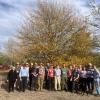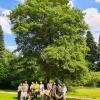Editor's Picks
Plant Focus
Pamela Frickmann Sanchez and Zarah Wyly
Published May 2019 in International Oaks No. 30: 93–100
Abstract
For over 30 years, the Sacramento Tree Foundation’s Seed to Seedling program has recruited classes of K-4 students to grow acorns into seedling oak trees. While growing native oak seedlings inside their classrooms, teachers lead students through a standards-based curriculum, available for free online, that is focused on the native oaks of the Sacramento region and the benefits of urban forest trees. Seed to Seedling supports other Sacramento Tree Foundation programs by generating high-quality and genetically-appropriate seedling oak trees for reforestation projects in the Sacramento area and for specific efforts such as oak reestablishment following the 2017 Wine Country Fires. With a simple, low-cost program model, the Seed to Seedling curriculum and program could be easily adapted to other oak communities and students around the world. This holistic program ensures the continuity of our native oak heritage and brings oaks into the city, into classrooms, and into the hearts of the next generation.
Keywords
community involvement with trees, growing oaks, tree teaching programs, urban forest
References
Bay Institute. 1998. From Sierra to the Sea: the Ecological History of the San Francisco Bay-Delta Watershed. San Rafael, CA: The Bay Institute of San Francisco.
CDFWVCMP & GIC. (California Department of Fish and Wildlife Vegetation Classification and Mapping Program & Geographical Information Center). 2013. Fine-Scale Riparian Vegetation Mapping of the Central Valley Flood Protection Plan Area, Final Report. Chico, CA: California State University, Geographical Information Center.
Greco, S.E. and D.A Airola. 2018. The importance of native valley oaks (Quercus lobata) as stopover habitat for migratory songbirds in urban Sacramento, California, USA. Urban Forestry & Urban Greening 29: 303-311.
Mendenhall, C., A. Shields-Estrada, A. Krishnaswami, and G. Daily. 2016. Quantifying and sustaining biodiversity in tropical agricultural landscapes. Proceedings of the National Academy of Sciences 113(51): 14544-14551.
Ulmer, J., K. Wolf, D. Backman, R. Tretheway, C. Blain, J. O’Neil-Dunne, and L. Frank, L. 2016. Multiple health benefits of urban tree canopy: The mounting evidence for a green prescription. Health & Place 42: 54-62.
Wolf, K.L. 2007. City Trees and Property Values. Arborist News 16(4): 34-36.















